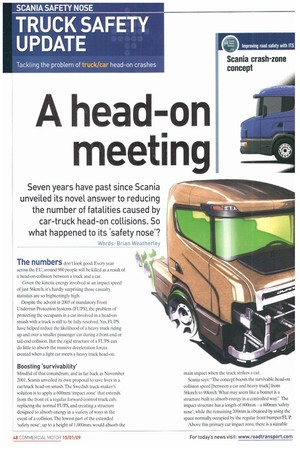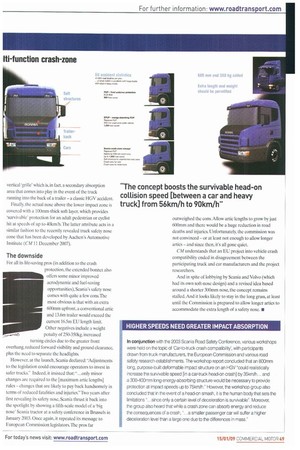A head-on meeting
Page 48

Page 49

If you've noticed an error in this article please click here to report it so we can fix it.
Seven years have past since Scania unveiled its novel answer to reducing the number of fatalities caused by car-truck head-on collisions. So what happened to its 'safety nose'?
Words: Brian Weathertey
The numbers don't look good. Every year across the EU. around 900 people will be killed as a result of a head-on-collision between a truck and a car.
Given the kinetic energy involved at an impact speed of just 56km/h, it's hardly surprising those casualty statistics are so frighteningly high.
Despite the advent in 2003 of mandatory Front Underrun Protection Systems (FLTPS), the problem of protecting the occupants in a car involved in a head-on smash with a truck is still to be fully resolved. Yes, FUPS have helped reduce the likelihood of a heavy truck riding up and over a smaller passenger car during a front-end or tail-end collision. But the rigid structure of a PUPS can do little to absorb the massive deceleration forces created when a light car meets a heavy truck head-on.
Boosting 'survivability' Mindful of that conundrum, and as far back as November 2001, Scania unveiled its own proposal to save lives in a car/truck head-on smash. The Swedish truck-maker's solution is to apply a 600mm 'impact zone' that extends from the front of a regular forward-control truck cab, replacing the normal FUPS, and creating a structure designed to absorb energy in a variety of ways in the event of a collision, The lowest part of the extended 'safety nose', up to a height of 1,000mm, would absorb the main impact when the truck strikes a car.
Scania says: "The concept boosts the survivable head-on collision speed [between a car and heavy truck] from 561(m/h to 90krn/h.What may seem like a bonnet is a structure built to absorb energy in a controlled way" The impact structure has a length of 800mm a 600nun 'safety nose', while the remaining 200mm is obtained by using the space normally occupied by the regular front bumper/FUP, Above this primary car impact zone, there is a sizeable vertical 'grille' which is, in fact, a secondary absorption area that comes into play in the event of the truck running into the back of a trailer — a classic HGV accident.
Finally, the actual nose above the lower impact zone is covered with a 100mm-thick soft layer, which provides 'survivable protection for an adult pedestrian or cyclist hit at speeds of up to 40km/h.The latter attribute acts in a similar fashion to the recently revealed truck safety nose cone that has been developed by Aachen's Automotive Institute (CM 11 December 2007).
The downside For all its life-saving pros (in addition to the crash protection, the extended bonnet also offers some minor improved aerodynamic and fuel-saving opportunities), Scania's safety nose comes with quite a few cons. The most obvious is that with an extra 600mm upfront, a conventional artic and 13.6m trailer would exceed the current 16.5m EU length limit.
Other negatives include a weight penalty of 250-350kg. increased turning circles due to the greater front overhang, reduced forward visibility and ground clearance, plus the need to separate the headlights.
However, at the launch, Scania declared: "Adjustments to the legislation could encourage operators to invest in safer trucks.Indeed, it insisted that: "...only minor changes are required to the [maximum artic lengths] rules — changes that are likely to pay back handsomely in terms of reduced fatalities and injuries." Two years after first revealing its safety nose, Scania thrust it hack into the spotlight by showing a fifth-scale model of a 'big nose' Scania tractor at a safety conference in Brussels in January 2003. Once again, it repeated its message to European Commission legislators. The pros far outweighed the cons. Allow artic lengths to grow by just 600min and there would be a huge reduction in road deaths and injuries. Unfortunately, the commission was not convinced — or at least not enough to allow longer artics — and since then, it's all gone quiet.
CM understands that an EU project into vehicle crash compatibility ended in disagreement between the participating truck and car manufacturers and the project researchers.
And in spite of lobbying by Scania and Volvo (which had its own soft-nose design) and a revised idea based around a shorter 300mm nose, the concept remains stalled. And it looks likely to stay in the long grass, at least until the Commission is prepared to allow longer artics to accommodate the extra length of a safety nose. •




















































































































































